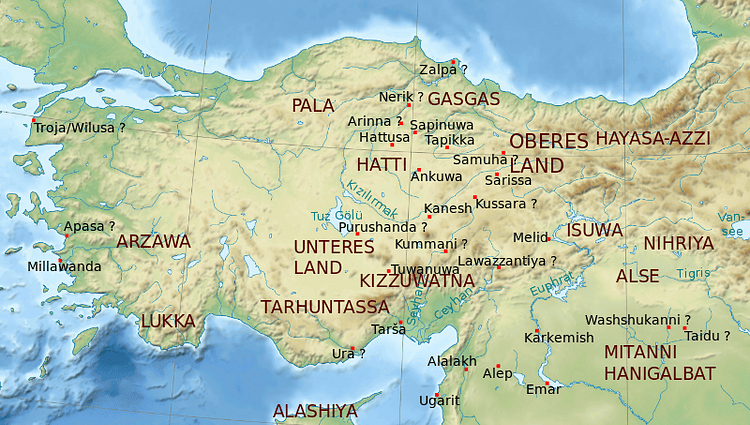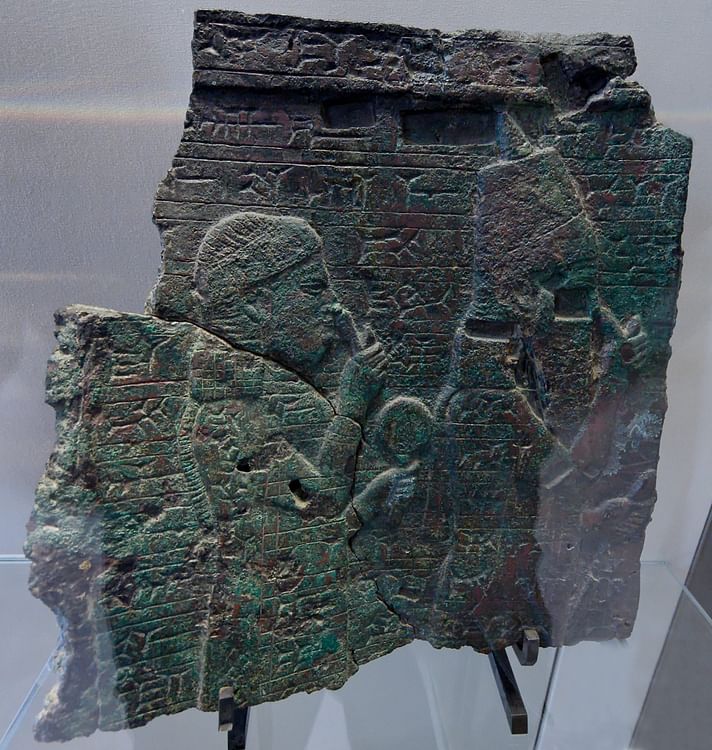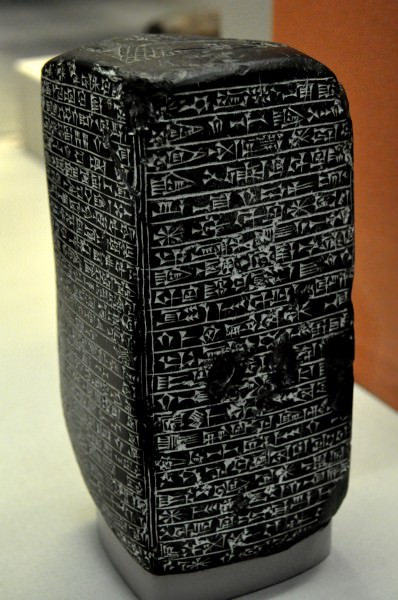Hayasa-Azzi › Zakutu » Ancient origins
Articles and Definitions › Contents
- Hayasa-Azzi › Antique Origins
- Zakutu › Who Was
Ancient civilizations › Historical and archaeological sites
Hayasa-Azzi › Antique Origins
Definition and Origins

The Hayasa-Azzi were an indigenous Bronze Age tribal confederation which flourished on the plateau of ancient Armenia and Turkey between c. 1500 and c. 1200 BCE. Although the historical record is impoverished and disputed regarding the region at this time, it is known that they were enemies of the powerful Hittites further to the east, were probably infiltrated by the Thraco-Phrygians following the collapse of the Hittite Empire c. 1200 BCE, and then became part of the kingdom of Urartufrom the 9th century BCE.
ORIGINS
The Hayasa-Azzi are the eponym of the Hay people, the term Armenians use to describe themselves and their state, Hayastan. Whether there is an actual connection between the ancient Hayasa-Azzi people and the more modern Armenia state (which only first appears in records from the 6th century BCE) is still being debated amongst scholars. The first mention in the historical record of the people of the Armenian highlands is in inscriptions of the Assyrian king Shalmaneser I (r. 1274-1245 BCE) in which they are referred to as the Uruatri. The term, meaning “of the mountainous country”, likely refers to all tribes of the region and not one particular kingdom. In inscriptions of the Assyrian king Tukulti-Ninurta I (r. 1244-1208 BCE) the region is referred to as “the Land of the Nairi” and tribute is extracted from it; 43 different kings are mentioned, indicating the area had not yet achieved political unity.
THE PEOPLE, AS WITH THEIR REGIONAL SUCCESSORS IN LATER TIMES, BECAME ADEPT AT ANIMAL HUSBANDRY& FAMED HORSE-BREEDERS.
The confederation known as the Hayasa-Azzi probably included other tribes such as the Alzi (Alshe) to the south. The territory the confederation of kingdoms controlled likely extended from Ararat in the east and straddled the western Euphrates River in the south but, again, details are lacking and disputed. The heartland was, at least as presented in later tradition, in the region of Erznga (Erzinjan) on the plain of Erzerum, northwest of Lake Van.
PROSPERITY
Protected by the high altitude of the plain of Ararat with its encircling mountains and with access from Mesopotamia limited to the southwest and across the Euphrates River, the Hayasa-Azzi benefitted from a certain isolation from foreign enemies while the local geography still permitted trade links. The mountains to the south, in particular, were a formidable barrier to ancient invaders and so two distinct areas of culture developed: the more advanced Mesopotamian civilizations of the lowlands to the south and the more isolated upland plateau. However, with fertile lands and natural resources such as gold, the Hayasa-Azzi flourished. The people, as with their regional successors in later times, became adept at animal husbandry and famed horse-breeders. The pottery produced was not painted (as it was to the south) but had a highly polished black finish.

Hittite War Chariot
THE HITTITES
Four consecutive Hayasa-Azzi kings are known from the period 1390 to 1335 BCE; they are Karannish, Mariyash, Hukkanash, and Anniyash. Their dealings with the Hittite Empire illustrate the ambivalent relationship between the two states. Karannish attacked the Hittites but was rebuffed by Tudhaliya II and then by Suppiluliuma I (rc 1344-1322 BCE) who was busy expanding his empire in all directions. A friendlier state of affairs is indicated by Mariyash's marriage to a Hittite princess, although he was later executed for breaching his matrimonial contract with the Hittites, to whom the Hyasa-Azzi may now have been a vassal state. Nevertheless, the arrangement was repeated when King Hukkanash married the sister of Suppiluliumaand prisoners of war were released as a consequence by both sides. Anniyash was more aggressive and attacked several Hittite outposts and then refused to release any of the prisoners he had captured. Then the Hittite king Mursili II (rc 1321–1295 BCE) moved eastwards and invaded Hayasa, a campaign recorded in inscriptions such as here from the Annals of Mursil:
And as I was returning from Astatan to Carchemish, the royal prince Nana-Lu came to meet me on the road and said, 'The Hayasan enemy having besieged Ganuvara, Nuvanza marched against him and met him under the walls of Ganuvara. Ten thousand men and seven hundred chariots were drawn up in battle against him, and Nuvanza defeated them. There are many dead and many prisoners.' (in Kurkjian, 31)
The Hayasa-Azzi were severely weakened but saved from total collapse by the onset of winter and consequent withdrawal of the Hittite army, and, in the longer term, by the ultimate demise of the Hittite empire c. 1200 BCE following invasions from elsewhere, notably by the Sea Peoples.
URARTU
Over time the Hayasa-Azzi mixed with other local tribes such as the Arme-Shupria and Nairi, probably motivated by the need for defence against more aggressive and powerful neighbours such as the Hittites and then the Assyrians in the southeast.Eventually, these various kingdoms would be fused into the region's first recognisable and recorded state, the kingdom of Urartu. With its capital at Tushpa, the Urartu civilization would flourish in Armenia, eastern Turkey, and western Iran from the 9th to 6th century BCE.
This article was made possible with generous support from the National Association for Armenian Studies and Researchand the Knights of Vartan Fund for Armenian Studies.
Zakutu › Who Was
Definition and Origins

Zakutu (c. 701-c.668 BCE) was the Akkadian name of Naqia, a wife of King Sennacherib of Assyria, who reigned between 705-681 BCE. Though she was not Sennacherib's queen, she bore him a son, Esarhaddon, who would succeed him. She ruled as Queen after her son's death and was grandmother to his successor, King Ashurbanipal. Writings about Naqia-Zakutu come mainly from the reign of Esarhaddon and give evidence of a strong and clever woman who rose from obscurity to greatness.
Naqia-Zakutu is known to have been associated with Sennacherib as early as 713 BCE when he was the crown prince under Sargon II. Sennacherib would have at least eleven (possibly more) sons with his wives and, among these, Esarhaddon was the youngest. As Zakutu was considered merely a 'palace woman', not a noble woman, the elder brothers seem to have taken little notice of her or her son. Sennacherib's favorite son and chosen heir, Ashur -nadin-shumi, was appointed ruler of Babylon from which he was kidnapped by the Elamites (Assyria's enemies) sometime around 695 BCE. He was most likely killed by his captors c. 694 BCE and Sennacherib needed to choose a son to replace him as heir. Sennacherib was busy with military campaigns and then building projects and seems to have taken his time making his decision regarding his successor. It is possible that he was evaluating his sons to see who was most fit to rule after him.
It would have come as an unpleasant surprise to Esarhaddon's older brothers when, in 683 BCE, Sennacherib chose his youngest son to succeed him. Some scholars maintain that Zakutu's maneuvering was behind the decision but this has been contested. The brothers took great exception to his choice and, in fear for his life, Zakutu sent Esarhaddon into hiding somewhere in the region formerly known as Mitanni. Two of Sennacherib's sons assassinated the king in 681 BCE, probably because of his sacrilege in destroying the city of Babylon and carrying off the statue of the great god Marduk, but possibly simply to gain the throne. Esarhaddon was then recalled from exile, probably by Zakutu, defeated his brothers in a six-week civil war, and took the throne. He then had his brother's families and associates executed. Esarhaddon ruled from 681 to 669 BCE, when he died while on campaign in Egypt. The throne then passed to his son, Ashurbanipal (685-627 BCE, reigned 668-627 BCE) the last king of the Neo-Assyrian Empire who, among other accomplishments, established the famous library at Nineveh.
ZAKUTU HELD AN IMPRESSIVE PLACE AT COURT DURING THE REIGN OF ESARHADDON, CARRYING THE TITLE OF 'QUEEN'.
Zakutu held an impressive place at court during the reign of Esarhaddon, carrying the title of 'Queen', drafting letters and receiving dignitaries even though she was not Assyrian ('Naqia' being either Aramaean or Hebrew in origin) and had never been queen to Senacherib (though, after Esarhaddon was named successor, she was known as 'mother of the crown prince').Letters on important matters were addressed to her as "To the mother of the king, my lord" and began with salutations of, "Greetings to the mother of the king, my lord. May the gods Ashur, Shamash and Marduk keep the king my lord in health. May they decree well-being for the mother of the king my lord" before relating the matter at hand. The historian Wolfram von Soden describes Zakutu's continued importance at court: "The Syrian-born wife of Sennacherib, Naqiya-Zakutu, still possessed considerable influence during the first years of the reign of her grandson, Ashurbanipal, and was feared by the royal officials" (67).

Stone Monument of Esarhaddon
Either just before, or just after, Esarhaddon's death in 669 BCE, Zakutu issued the Loyalty Treaty of Naqia-Zakutu in either 670 or 668 BCE to secure Ashurbanipal's succession, ordering the court and country recognize her grandson as their legitimate ruler. The treaty reads, in part:
Anyone who is in this treaty which Queen Zakutu has concluded with the whole nation concerning her favorite grandson Ashurbanipal shall not revolt against your lord Ashurbanipal, King of Assyria, or in your hearts conceive and put into words an ugly scheme or an evil plot against your lord Ashurbanipal, or plot with another for the murder of your lord Ashurbanipal, King of Assyria. May Ashur, Sin, Shamash and Ishtar bear witness and curse violators of this treaty.
The Treaty clearly identifies Zakutu as Queen at this time and the fact that she could issue such a decree indicates she enjoyed sufficient power and support to be able to ensure the succession of her grandson as king. From a land purchase contract it is known that she had a sister, Abirami, but little other personal details of Zakutu's life have come to light. Even her birth and death dates are unknown; yet her influence on the reigns of these two great Mesopotamian kings was significant.Exactly how she was able to ascend to her position of power at court may be waiting in future archaeological finds in the region but, at present, it is at least clear she was instrumental in the rise of two of the most important kings of the Neo-Assyrian Empire.
LICENSE:
Article based on information obtained from these sources:with permission from the Website Ancient History Encyclopedia
Content is available under License Creative Commons: Attribution-NonCommercial-ShareAlike 3.0 Unported. CC-BY-NC-SA License